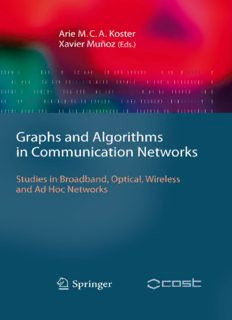Table Of ContentTexts in Theoretical Computer Science
An EATCS Series
Editors:W.Brauer J.Hromkovicˇ G.Rozenberg A.Salomaa
OnbehalfoftheEuropeanAssociation
forTheoreticalComputerScience(EATCS)
AdvisoryBoard:
G.Ausiello M.Broy C.S.Calude A.Condon
D.Harel J.Hartmanis T.Henzinger T.Leighton
M.Nivat C.Papadimitriou D.Scott
Forfurthervolumes:
http://www.springer.com/series/3214
·
Arie M.C.A. Koster Xavier Mun˜oz
Editors
Graphs and Algorithms
in Communication Networks
Studies in Broadband, Optical, Wireless
and Ad Hoc Networks
123
Editors
Prof.Dr.Ir.ArieM.C.A.Koster Prof.XavierMun˜oz
LehrstuhlIIfu¨rMathematik Dept.deMatema`ticaAplicadaIV
RWTHAachen UniversitatPolite`cnicadeCatalunya
Germany Barcelona
[email protected] Spain
[email protected]
ISSN1862-4499
ISBN978-3-642-02249-4 e-ISBN978-3-642-02250-0
DOI10.1007/978-3-642-02250-0
SpringerHeidelbergDordrechtLondonNewYork
LibraryofCongressControlNumber:2009940112
MathematicsSubjectClassification(1998):F.2,G.2,G.4,I.6,C.2,G.1.6
(cid:2)c Springer-VerlagBerlinHeidelberg2010
Thisworkissubjecttocopyright.Allrightsarereserved,whetherthewholeorpartofthematerialis
concerned,specificallytherightsoftranslation,reprinting,reuseofillustrations,recitation,broadcasting,
reproductiononmicrofilmorinanyotherway,andstorageindatabanks.Duplicationofthispublication
orpartsthereofispermittedonlyundertheprovisionsoftheGermanCopyrightLawofSeptember9,
1965,initscurrentversion,andpermissionforusemustalwaysbeobtainedfromSpringer.Violations
areliabletoprosecutionundertheGermanCopyrightLaw.
Theuseofgeneraldescriptivenames,registerednames,trademarks,etc.inthispublicationdoesnot
imply,evenintheabsenceofaspecificstatement,thatsuchnamesareexemptfromtherelevantprotective
lawsandregulationsandthereforefreeforgeneraluse.
Coverdesign:KuenkelLopkaGmbH
Printedonacid-freepaper
SpringerispartofSpringerScience+BusinessMedia(www.springer.com)
COST
COST,theacronymforEuropeanCOoperationinthefieldofScientificandTechni-
calResearch,istheoldestandwidestEuropeanintergovernmentalnetworkforco-
operationinresearch.EstablishedbytheMinisterialConferenceinNovember1971,
COSTispresentlyusedbythescientificcommunitiesof35Europeancountriesto
cooperateincommonresearchprojectssupportedbynationalfunds.
The funds provided by COST, less than 1% of the total value of the projects,
support the COST cooperation networks (COST Actions) through which, with 30
millionEuroperyear,morethan30,000Europeanscientistsareinvolvedinresearch
having a total value which exceeds two billion Euro per year. This is the financial
worthoftheEuropeanaddedvaluewhichCOSTachieves.
A“bottom-upapproach”(theinitiativeoflaunchingaCOSTActioncomesfrom
the European scientists themselves), “a` la carte participation” (only countries in-
terested in the Action participate), “equality of access” (participation is open also
to the scientific communities of countries not belonging to the European Union)
and“flexiblestructure”(easyimplementationandlightmanagementoftheresearch
initiatives)arethemaincharacteristicsofCOST.
As a precursor of advanced multidisciplinary research, COST has a very im-
portant role for the realization of the European Research Area (ERA), anticipat-
ing and complementing the activities of the Framework Programmes, constituting
a“bridge”tothescientificcommunitiesofemergingcountries,increasingthemo-
bility of researchers across Europe, and fostering the establishment of “Networks
of Excellence” in many key scientific domains such as Biomedicine and Molecu-
lar Biosciences; Food and Agriculture; Forestry Products and Services; Materials,
Physical,andNanosciences;ChemistryandMolecularSciencesandTechnologies;
Earth System Science and Environmental Management; Information and Commu-
nication Technologies; Transport and Urban Development; Individuals, Societies,
Cultures,andHealth.Itcoversbasicandmoreappliedresearchandalsoaddresses
issuesofpre-normativenatureorofsocietalimportance.
Web:www.cost.esf.org
ESFprovidestheCOSTofficethroughanECcontract
COSTissupportedbytheEURTDFrameworkprogramme
Preface
Communicationnetworksareavitalandcrucialelementoftoday’sworld.Mobile
devices,theInternet,andallnewapplicationsandservicesprovidedbythesemedia
havechangeddramaticallythewaybothindividuallivesandsocietyasawholeare
organized.Alltheseservicesdependonfastandreliabledataconnections,whether
wiredorwireless.Tomeetsuchrequirements,informationandcommunicationtech-
nologyischallengedagainandagaintoprovidefasterprotocols,wirelessinterfaces
with higher bandwidth capacity, innovative mechanisms to handle failures, and so
on.
Formanyofthosechallengesavarietyofmathematicaldisciplinescontributein
asupportiverole,eitherinprovidinginsights,evidence,oralgorithmsorasdecision
supporttools.Inparticular,thebroadareaofalgorithmicdiscretemathematicsplays
acrucialroleinthedesignandoperationofcommunicationnetworks.However,the
discipline is fragmented between scientific disciplines such as pure mathematics,
theoretical computer science, distributed computing, and operations research. Fur-
thermore,researchersfromcommunicationengineeringutilizediscretemathemati-
caltechniquesanddeveloptheirownextensions.
Withtheaimtobringtogethertheabove-mentioneddisciplinesanddrawsynergy
effectsfromit,theCOSTaction293–GraphsandAlgorithmsinCommunication
Networks – was launched in October 2004 for a period of four years. Scientists
fromtheabovedisciplineshavebeengatheringonaregularbasistolearnfromeach
otherandtoworkjointlyonemergingapplicationstothebenefitoftheinformation
andcommunicationtechnologysociety.Alsoworkshopsandtrainingschoolshave
been organized to disseminate recent advances in all subject areas. An active ex-
changeprogramme(short-termscientificmissionsinCOSTterminology)between
theresearchgroupshasresultedinahighnumberofjointpublications.
To document on the one hand the multidisciplinary research carried out within
COST 293 and on the other hand to encourage further collaborations between the
disciplines,thisbookpresentsanumberofstudiesinbroadband,optical,wireless,
andadhocnetworkswherethetechniquesofalgorithmicdiscretemathematicshave
providedhighlyrecognizedcontributions.
viii Preface
Thewaythestudiesarepresented,thisbookisparticularlysuitedforPh.D.stu-
dents, postdoctoral researchers in mathematics, computer science, operations re-
search, and network engineering as well as industrial researchers who would like
toinvestigatestate-of-the-artmathematicalalternativestoresolvethetechnological
challengesoftomorrow.Anintroductorychaptershouldeaseaccesstothematerial
forresearchersnotfamiliarwiththemathematicalterminologyusedbythechapters’
authors.
As chair and vice-chair of COST 293, it has been a pleasure for us to prepare
this book. We would like to thank all authors and reviewers for the contributions.
Withouttheirvoluntaryhelpitwouldhavebeenimpossibletopublishthisbook.We
alsoaregratefultoCOSTforsupportingouractioningeneralandthedissemination
ofthisbookinparticular.
Coventry/Barcelona, ArieM.C.A.Koster
March2009 XavierMun˜oz
Contents
1 GraphsandAlgorithmsinCommunicationNetworksonSeven
LeagueBoots ............................................... 1
ArieM.C.A.KosterandXavierMun˜oz
1.1 Introduction.............................................. 1
1.2 MathematicalModeling.................................... 3
1.2.1 SetsandParameters ............................... 3
1.2.2 GraphsandNetworks .............................. 4
1.2.3 MathematicalProblems ............................ 7
1.2.4 DistributedProblems .............................. 9
1.2.5 OnlineDecisionProblems .......................... 10
1.3 ComputationalComplexity ................................. 11
1.4 CombinatorialOptimizationMethods ........................ 13
1.4.1 Linear-Programming-BasedMethods................. 14
1.4.2 GraphTheory..................................... 22
1.4.3 CombinatorialAlgorithms .......................... 23
1.4.4 ApproximationAlgorithms ......................... 23
1.4.5 HeuristicsWithoutSolutionGuarantee................ 24
1.4.6 NonlinearProgramming............................ 24
1.5 SelectedClassicalApplicationsinCommunicationNetworks .... 25
1.5.1 DesignofNetworkTopologies ...................... 25
1.5.2 NetworkRoutingProblems ......................... 29
1.5.3 NetworkPlanningProblems......................... 38
1.5.4 ARandomizedCostSmoothingApproachforOptical
NetworkDesign................................... 40
1.5.5 WirelessNetworking............................... 46
1.6 EmergingApplicationsinCommunicationNetworks ........... 53
1.6.1 BroadbandandOpticalNetworks .................... 53
1.6.2 WirelessandAdHocNetworks...................... 55
References..................................................... 56
x Contents
PartI StudiesinBroadbandandOpticalNetworks
2 TrafficGrooming:CombinatorialResultsandPracticalResolutions. 63
TiborCinkler,DavidCoudert,MicheleFlammini,GianpieroMonaco,
LucaMoscardelli,XavierMun˜oz,IgnasiSau,MordechaiShalom,and
ShmuelZaks
2.1 Introduction.............................................. 64
2.2 ProblemDefinitionandExamples ........................... 66
2.3 MinimizingtheUsageofLightTerminationEquipment ......... 70
2.3.1 Path............................................. 70
2.3.2 Ring ............................................ 71
2.3.3 GeneralTopology ................................. 71
2.3.4 OnlineTraffic..................................... 72
2.3.5 PriceofAnarchy .................................. 72
2.4 MinimizingtheNumberofAdd/DropMultiplexers ............. 73
2.4.1 ComplexityandInapproximabilityResults ............ 74
2.4.2 ApproximationResults............................. 75
2.4.3 SpecificConstructions ............................. 76
2.4.4 APrioriPlacementoftheEquipment ................. 77
2.5 MultilayerTrafficGroomingforGeneralNetworks ............. 78
2.5.1 MultilayerMeshNetworks.......................... 79
2.5.2 OnGroominginMultilayerMeshNetworks ........... 80
2.5.3 GraphModelsforMultilayerGrooming............... 81
2.6 Conclusion............................................... 87
References..................................................... 88
3 Branch-and-Cut Techniques for Solving Realistic Two-Layer
NetworkDesignProblems .................................... 95
SebastianOrlowski,ChristianRaack,ArieM.C.A.Koster,Georg
Baier,ThomasEngel, andPietroBelotti
3.1 Introduction.............................................. 96
3.2 MathematicalModel....................................... 98
3.2.1 Mixed-IntegerProgrammingModel .................. 98
3.2.2 Preprocessing.....................................101
3.3 MIP-BasedHeuristicsWithinBranch-and-Cut .................103
3.3.1 ComputingCapacitiesoveraGivenFlow .............103
3.3.2 ReroutingFlowtoReduceCapacities.................104
3.4 CuttingPlanes............................................105
3.4.1 CuttingPlanesontheLogicalLayer..................105
3.4.2 CuttingPlanesonthePhysicalLayer .................108
3.5 ComputationalResults.....................................109
3.5.1 TestInstancesandSettings..........................109
3.5.2 UnprotectedDemands..............................110
3.5.3 ProtectedDemands ................................113
3.5.4 PreprocessingandHeuristics ........................114
Contents xi
3.6 Conclusions..............................................116
References.....................................................116
4 RoutingandLabelSpaceReductioninLabelSwitchingNetworks .. 119
FernandoSolano,LuisFernandoCaro,ThomasStidsen,andDimitri
Papadimitriou
4.1 IntroductiontoLabelSwitching .............................119
4.2 FunctionalDescriptionoftheTechnologies....................121
4.2.1 Multi-protocolLabelSwitchingTrafficEngineering
(MPLS-TE) ......................................121
4.2.2 All-OpticalLabelSwitching(AOLS) .................122
4.2.3 EthernetVLAN-LabelSwitching(ELS)...............122
4.3 MethodsforScalingtheUsageoftheLabelSpace..............123
4.3.1 LabelMerging....................................123
4.3.2 LabelStacking....................................124
4.4 ConsideringRouting.......................................126
4.5 GenericModel ...........................................128
4.5.1 ParametersandVariables ...........................128
4.5.2 Integer Linear Program for the Network
DesignProblem...................................129
4.5.3 TrafficEngineeringFormulation .....................130
4.5.4 NoLabelStacking.................................131
4.6 SimulationResults ........................................131
4.6.1 MPLS-TE........................................131
4.6.2 AOLS ...........................................132
4.6.3 ELS.............................................134
4.7 ConclusionsandFutureWork ...............................135
References.....................................................136
5 NetworkSurvivability:End-to-EndRecoveryUsingLocalFailure
Information ................................................ 137
Jose´ L.Marzo,ThomasStidsen,SarahRuepp,EusebiCalle,Janos
Tapolcai,andJuanSegovia
5.1 BasicConceptsonNetworkSurvivability .....................138
5.1.1 ProtectionandRestoration ..........................138
5.1.2 TheScopeofBackupPaths .........................139
5.1.3 ShareabilityofProtectionResources..................140
5.2 TheFailure-DependentPathProtectionMethod ................141
5.2.1 RecoveryBasedontheFailureScenario...............141
5.2.2 PathAssignmentApproaches .......................143
5.2.3 GeneralSharedRiskGroups(SRG) ..................143
5.2.4 TheInputoftheProblem ...........................144
5.2.5 Two-StepApproaches..............................145
5.2.6 JointOptimization:TheGreedyApproach.............146
5.3 Multi-commodityConnectivity(MCC) .......................147
Description:Algorithmic discrete mathematics plays a key role in the development of information and communication technologies, and methods that arise in computer science, mathematics and operations research – in particular in algorithms, computational complexity, distributed computing and optimization – ar

